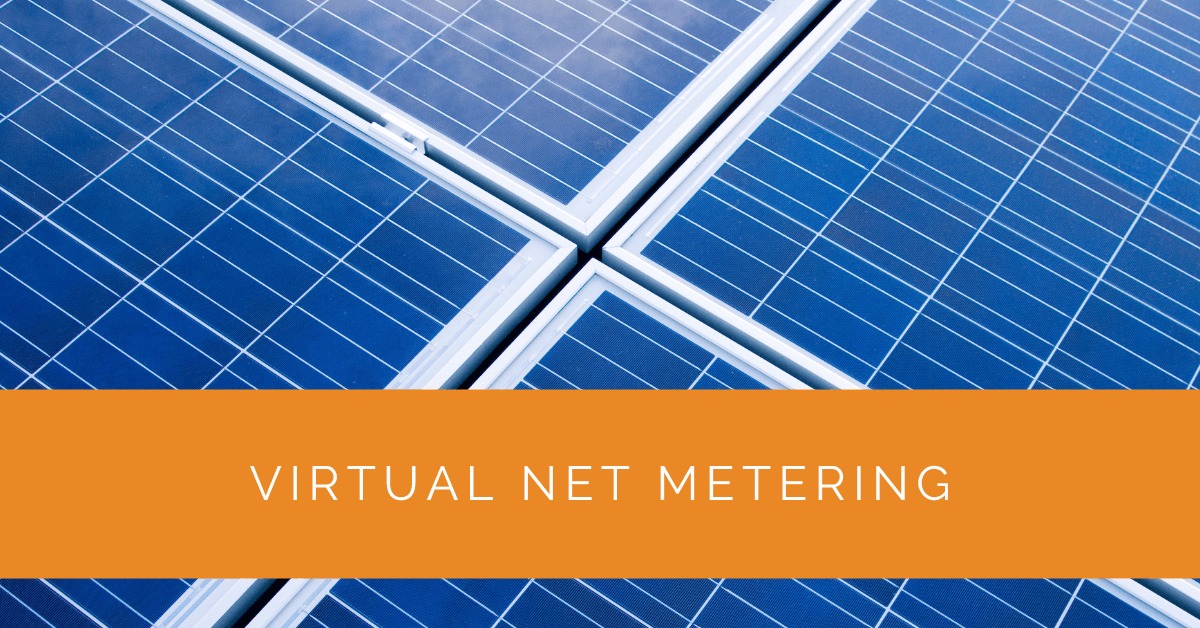In our quest for sustainable energy solutions, virtual net metering (VNM) is a powerful tool to democratize solar energy access and foster renewable energy adoption. This article delves into virtual net metering, explores its advantages, and demystifies the billing mechanism underpinning this innovative approach.
Contents
- 1 Key Takeaways
- 2 How Virtual Net Metering Works
- 3 The Advantages of Virtual Net Metering
- 4 Implementing Virtual Net Metering Programs
- 5 Billing and Cost Allocation
- 6 Future Outlook for Virtual Net Metering
- 7 Net Metering Savings Calculator
- 8 Case Study: Implementing Virtual Net Metering for Community Solar Projects
- 9 Expert Insights From Our Solar Panel Installers About Virtual Net Metering
- 10 Experience Solar Excellence with Us!
- 11 Conclusion
Key Takeaways
- Virtual net metering enables equitable distribution of solar energy among multiple properties, fostering renewable energy adoption.
- Advantages include empowering shared solar projects, providing access to solar benefits for multifamily dwellings, and supporting low-income communities.
- Successful implementation requires careful planning, stakeholder collaboration, and transparent billing mechanisms.
How Virtual Net Metering Works
Virtual net metering allows solar energy produced by a single solar panel system to be shared among multiple properties or meters. The excess energy generated by a solar panel system is transferred to the grid and credited to the accounts of participating properties, enabling them to offset their electricity consumption with renewable energy credits. Virtual net metering is particularly advantageous for multi-tenant buildings, multifamily dwellings, and shared solar projects, facilitating equitable distribution of solar benefits.
Understanding Virtual Net Energy Metering (VNEM) and Its Variants
Virtual net energy metering (VNEM) encompasses several sub-programs that cater to different scenarios. Shared solar projects, where multiple participants collectively own or subscribe to a solar system, employ VNEM to allocate net metering credits. Community solar programs enable subscribers to receive credits from remotely located solar arrays. VNEM variants include multi-meter and common area virtual net metering tailored for multi-tenant buildings and properties with shared spaces.
Virtual Net Metering vs. Traditional Net Metering: Key Differences
Traditional net metering typically involves a one-to-one relationship between a solar system and a single meter. In contrast, virtual net metering facilitates energy sharing among multiple meters, enabling solar energy to benefit a broader array of properties. This key difference significantly expands the reach of renewable energy and supports equitable access to solar power.

The Advantages of Virtual Net Metering
Virtual net metering offers various advantages that contribute to the growth of renewable energy and sustainability:
Virtual net metering fosters the development of shared solar and community solar projects. It democratizes solar energy access by allowing individuals who may not have suitable rooftops for solar panels to invest in and benefit from remote solar arrays.
Increased Access to Solar Benefits for Multifamily Dwellings
Installing individual solar systems for each unit may be impractical in multifamily dwellings. Virtual net metering enables a single solar system to serve multiple units, lowering installation costs and allowing all residents to participate in renewable energy generation.
Supporting Renewable Energy Growth in Low-Income Communities
Virtual net metering extends renewable energy benefits to low-income communities and renters, who might otherwise face barriers to installing solar panels. Virtual net metering fosters inclusivity in the renewable energy transition by enabling shared solar and equitable energy distribution.
Implementing Virtual Net Metering Programs
Successful virtual net metering programs require a carefully planned approach and collaboration between stakeholders:
State and Utility Approaches to Virtual Net Metering
Adopting virtual net metering varies across states, and individual utilities may have specific programs. Some states have well-established virtual net metering regulations, while others may develop or expand such programs.
Eligibility Criteria and Enrollment Process for Virtual Net Metering
Property owners or subscribers must meet certain eligibility criteria set by the utility or program administrator to participate in virtual net metering. These criteria may relate to the size of the solar system, type of property, or location within the service territory.
Addressing Technical and Regulatory Challenges
Implementing virtual net metering programs may present technical and regulatory challenges. Ensuring accurate energy measurement, equitable credit allocation, and billing transparency require thoughtful planning and stakeholder coordination.

Billing and Cost Allocation
A key aspect of virtual net metering is the billing mechanism that enables the allocation of net metering credits among participating properties:
Understanding Virtual Net Metering Billing Mechanism
Virtual net metering billing involves the calculation of net energy credits (NEC) generated by the solar panel system and their equitable distribution among participating properties. The NEC is determined based on the difference between the energy produced by the solar system and the energy consumed by the participating properties.
Calculating Credits and Savings for Virtual Net Metering Participants
Each participating property receives net metering credits corresponding to its share of the solar energy produced. These credits are applied to the property’s utility bill, offsetting the electricity consumption and resulting in cost savings for the participants.
Cost Allocation Among Virtual Net Metering Subscribers
The billing process includes cost allocation mechanisms to ensure fair distribution of expenses among virtual net metering subscribers. Various allocation methods, such as pro-rata and subscription-based models, are used based on program design and regulations.
Future Outlook for Virtual Net Metering
As the renewable energy landscape evolves, virtual net metering is poised for further expansion:
Potential Expansion and Growth of Virtual Net Metering Programs
With growing awareness of renewable energy’s importance, virtual net metering programs are expected to expand into new states and utilities, reaching a wider audience of participants.
Policy and Legislative Considerations for Enhanced Adoption
Policy support and legislative efforts can play a pivotal role in fostering the growth of virtual net metering. Advocating for favorable regulations and incentives can accelerate the adoption of virtual net metering programs.
Integrating Virtual Net Metering with Smart Grid Technologies
Integrating virtual net metering with smart grid technologies holds promise for more efficient and seamless energy management. This convergence can optimize energy distribution and enhance the overall performance of virtual net metering programs.
Net Metering Savings Calculator
Estimate your yearly savings under different net metering programs.
Case Study: Implementing Virtual Net Metering for Community Solar Projects
Background
Solar Panels Network USA has been at the forefront of advancing renewable energy solutions through innovative approaches like virtual net metering. This case study highlights our collaboration with a residential community to implement a virtual net metering system, showcasing the benefits and impact of shared solar energy projects.
Project Overview
Our client, a residential community association, sought to reduce overall energy costs and promote sustainability among residents. The goal was to develop a shared solar project providing clean energy to all community members, including those without individual solar installations.
Implementation
Initial Assessment
Our team conducted a comprehensive assessment of the community’s energy needs, available space for solar installations, and the potential for energy savings through virtual net metering. This assessment included evaluating rooftops, open spaces, and common areas suitable for installing a centralized solar array.
Project Planning and Design
Working closely with solar developers, we created a detailed project plan that included technical specifications, financing strategies, and timelines. The plan emphasized maximizing energy production and ensuring equitable distribution of benefits among all community members.
Securing Permits and Financing
Securing the necessary permits and approvals was a critical step in the project. We navigated the regulatory landscape, collaborating with local authorities to ensure compliance with all relevant regulations. Additionally, we explored various financing options, including public-private partnerships and community funding initiatives, to support the project’s financial viability.
Construction and Commissioning
The construction phase involved installing a centralized solar array on available rooftops and common areas. The solar developers managed the construction, ensuring high-quality installation and adherence to safety standards. Upon completion, the system was commissioned, and the virtual net metering arrangement was implemented to allocate energy credits to participating households.
Results
Increased Energy Savings
The implementation of virtual net metering resulted in significant energy savings for the community. By generating clean energy through the shared solar array, residents experienced reduced electricity bills and increased financial savings.
Enhanced Community Engagement
The project fostered a sense of community engagement and collective responsibility towards sustainability. Residents actively participated in the project, contributing to a shared vision of reducing the community’s carbon footprint and promoting renewable energy.
Environmental Benefits
The shared solar project contributed to substantial reductions in carbon emissions, supporting the community’s environmental goals. The project also demonstrated the potential for virtual net metering to drive large-scale adoption of renewable energy and create more sustainable communities.
Summary
This case study underscores the transformative potential of virtual net metering in promoting renewable energy adoption and achieving community-wide sustainability goals. By implementing a shared solar project, Solar Panels Network USA helped the residential community achieve significant energy savings, enhance community engagement, and reduce their environmental impact. This collaborative effort showcases the benefits of virtual net metering and highlights the importance of innovative approaches in advancing the clean energy transition.
Expert Insights From Our Solar Panel Installers About Virtual Net Metering
Virtual net metering breaks down barriers to solar energy access, making it possible for renters and residents of multi-family dwellings to benefit from renewable energy without installing individual solar systems.
Solar Energy Consultant
By leveraging shared solar projects, virtual net metering fosters a community approach to renewable energy, ensuring that everyone can participate in the clean energy transition.
Community Solar Project Manager
Implementing virtual net metering programs requires meticulous planning and collaboration among stakeholders, but the result is a more inclusive and sustainable energy system that benefits a wider range of people.
Renewable Energy Policy Specialist
Experience Solar Excellence with Us!
Trust in Solar Panels Network USA, where our seasoned experts deliver top-quality solar solutions for homes and businesses nationwide. With a legacy of countless successful installations and a commitment to sustainable energy, we’re your reliable partner in the solar journey. Ready for a brighter, eco-friendly future? Call us now at (855) 427-0058 and harness the power of the sun!
Conclusion
Virtual net metering is a transformative approach that bridges the gap between renewable energy generation and equitable access to solar benefits. By enabling shared solar projects, supporting multifamily dwellings, and empowering low-income communities, virtual net metering paves the way for a sustainable energy future. As virtual net metering programs continue to evolve and expand, their positive impact on the environment and communities reinforce the importance of renewable energy and collective efforts towards a greener planet.
About the Author
Solar Panels Network USA stands at the forefront of solar energy solutions, driven by a team of seasoned solar engineers and energy consultants. With over decades of experience in delivering high-quality solar installations and maintenance, we are committed to promoting sustainable energy through customer-centric, tailored solutions. Our articles reflect this commitment, crafted collaboratively by experts to provide accurate, up-to-date insights into solar technology, ensuring our readers are well-informed and empowered in their solar energy decisions.

